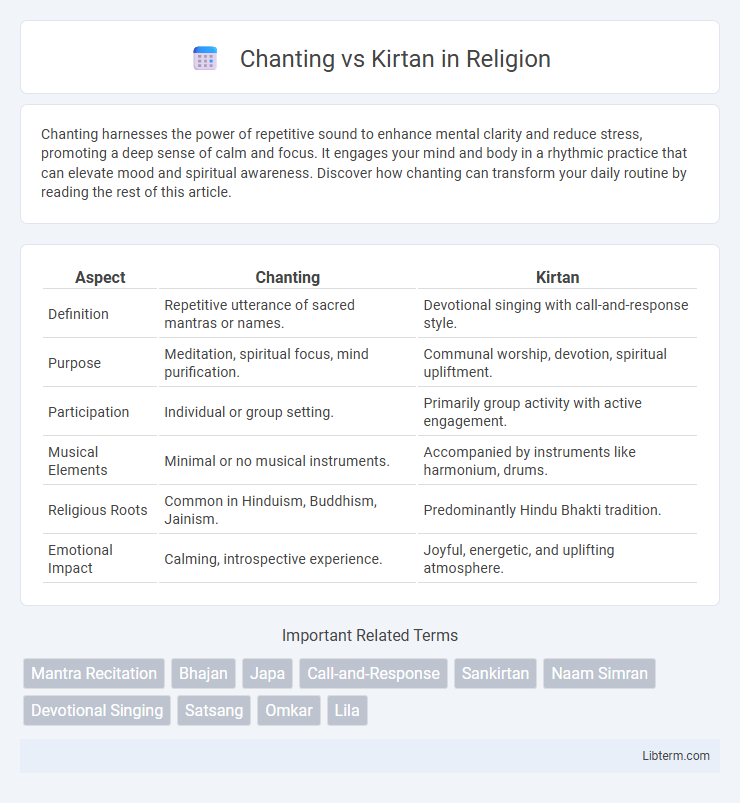Chanting harnesses the power of repetitive sound to enhance mental clarity and reduce stress, promoting a deep sense of calm and focus. It engages your mind and body in a rhythmic practice that can elevate mood and spiritual awareness. Discover how chanting can transform your daily routine by reading the rest of this article.
Table of Comparison
| Aspect | Chanting | Kirtan |
|---|---|---|
| Definition | Repetitive utterance of sacred mantras or names. | Devotional singing with call-and-response style. |
| Purpose | Meditation, spiritual focus, mind purification. | Communal worship, devotion, spiritual upliftment. |
| Participation | Individual or group setting. | Primarily group activity with active engagement. |
| Musical Elements | Minimal or no musical instruments. | Accompanied by instruments like harmonium, drums. |
| Religious Roots | Common in Hinduism, Buddhism, Jainism. | Predominantly Hindu Bhakti tradition. |
| Emotional Impact | Calming, introspective experience. | Joyful, energetic, and uplifting atmosphere. |
Introduction to Chanting and Kirtan
Chanting involves the repetitive vocalization of mantras or sacred phrases to induce meditation and spiritual focus, often performed individually or in small groups. Kirtan is a dynamic form of devotional singing, typically involving call-and-response gatherings with musical instruments that encourage communal participation and emotional connection. Both practices aim to elevate consciousness and promote inner peace through sound vibration, yet Kirtan emphasizes collective energy while chanting centers on personal spiritual discipline.
Origins and Historical Background
Chanting originates from ancient Vedic traditions in India, where repetitive recitation of sacred mantras served as a spiritual practice for meditation and invoking divine energies. Kirtan, rooted in Bhakti yoga, emerged around the 15th century as a communal singing of devotional hymns and praises to deities like Krishna and Rama, fostering collective participation and devotion. Both practices share origins in Indian spirituality but differ in format, with chanting often performed individually and kirtan emphasizing group interaction and call-and-response singing.
Defining Chanting: Key Concepts
Chanting involves the repetitive vocalization of specific mantras or sacred sounds aimed at focusing the mind and invoking spiritual energy. Key concepts include rhythm, vibration, and meditation, which help cultivate inner peace and heightened awareness. Unlike group-based practices, chanting can be performed individually or collectively, emphasizing personal or communal spiritual connection.
What is Kirtan? Core Elements
Kirtan is a devotional practice originating from the Bhakti tradition of Hinduism, characterized by call-and-response singing of sacred mantras or hymns. Core elements include repetitive vocalization, musical accompaniment with instruments like the harmonium, tabla, and cymbals, and collective participation, fostering spiritual connection and community bonding. Unlike simple chanting, Kirtan emphasizes interactive, melodic expression and emotional engagement to invoke devotion and mindfulness.
Musical Styles and Instruments Used
Chanting typically involves repetitive vocalization of mantras or sacred sounds, often performed solo or in a meditative group setting, using minimal or no musical instruments. Kirtan, a call-and-response musical style rooted in Indian devotional traditions, features dynamic vocal performances accompanied by instruments such as harmonium, tabla, mridangam, and cymbals to create an engaging and rhythmic experience. The primary distinction lies in kirtan's structured call-and-response format and rich instrumentation, contrasting with chanting's more solitary, mantra-focused delivery.
Spiritual and Psychological Benefits
Chanting involves repetitive vocalization of mantras or sacred sounds, promoting deep meditative states that enhance focus, reduce anxiety, and activate the parasympathetic nervous system. Kirtan combines call-and-response singing with musical accompaniment, creating a communal atmosphere that fosters emotional connection, elevates mood through rhythmic vibrations, and stimulates the release of endorphins and oxytocin. Both practices support spiritual growth by cultivating mindfulness, inner peace, and a heightened sense of unity with the divine and self.
Practices and Rituals: How They Differ
Chanting typically involves the repetitive vocalization of mantras or sacred sounds performed individually or in a meditative setting, emphasizing personal spiritual focus and concentration. Kirtan, on the other hand, is a dynamic group practice combining call-and-response singing, musical instruments, and communal participation designed to evoke collective devotion and shared emotional experience. While chanting centers on silent or monotone repetition aimed at internalization, kirtan incorporates rhythmic melodies and interactive rituals that foster social bonding and outward expression of faith.
Community vs. Individual Participation
Chanting often emphasizes individual participation, promoting personal meditation and inner focus, whereas kirtan centers on communal engagement with call-and-response singing that fosters group unity and collective spiritual experience. In kirtan sessions, participants actively contribute to the musical and vocal exchange, creating a shared atmosphere of devotion that strengthens community bonds. Conversely, chanting typically facilitates solitary reflection, allowing practitioners to deepen their personal spiritual connection through repetitive mantra recitation.
Global Influence and Modern Adaptations
Chanting and Kirtan have gained significant global influence through the spread of yoga and meditation practices, attracting diverse audiences beyond their traditional Indian origins. Modern adaptations of chanting incorporate digital platforms, global music festivals, and fusion with contemporary genres, enhancing accessibility and engagement. Kirtan events increasingly blend traditional call-and-response singing with modern musical instruments and sound technology, fostering community and spiritual connection worldwide.
Choosing Between Chanting and Kirtan
Choosing between chanting and kirtan depends on personal spiritual goals and preferences; chanting involves repetitive vocalization of mantras for meditation and mindfulness, promoting inner calm and focus. Kirtan integrates call-and-response singing often accompanied by musical instruments, fostering communal participation and emotional upliftment. Both practices offer unique benefits, with chanting suited for solitary reflection and kirtan enhancing group energy and devotional expression.
Chanting Infographic

 libterm.com
libterm.com